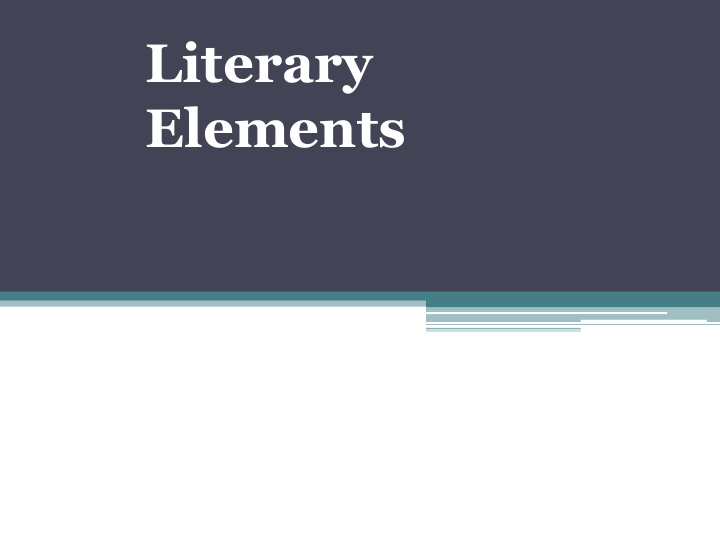



Literary Elements
OB OBJE JECT CTIVES IVES • Identify elements of a short story • Define elements of a short story • Demonstrate mastery of short story elements
OV OVERV ERVIE IEW Short t stories es often en contain n structura ural and chara ract cter er elements ts that should d be familiar ar to you. Thes ese e el elem emen ents ts can be e used ed as guides es to hel elp y you think about the actions, ns, themes, s, and context xts of the story.
• Plot • Theme - exposition statement • Setting - rising action • Characters *conflict - climax • Point of view - falling action • Characterization - resolution
THE HEME ME • The main idea of a literary work, usually expressed as a generalization. SE SETTING TTING • The time and place in which a work of literature happens.
Theme In literature, theme is a perception about life or human nature that the writer wants to share with the reader. In most cases, the theme is not stated directly but must be inferred . Themes can be revealed by - a story’s title - key phrases and statements about big ideas - the ways the characters change and the lessons they learn about life.
Setting= time and place -puts the reader in the story by giving the reader the feeling of being in the situation. -creates atmosphere by the positive or negative feelings associated with the place.
CHA HARA RACTE TERS RS • The people (or actors) in the story. PO POIN INT T OF OF VI VIEW EW • The story teller from whose point of view the story is being told, the narrator.
CH CHARA RACT CTERIZ RIZATIO ATION The description of the personalities of the characters in the story and the way in which an author reveals their personalities.
Methods of Characterization Creating Believable Characters • Indirect • Direct ▫ physical appearance ▫ the narrator’s direct comments about a character ▫ speech, thoughts, feelings, or actions of the character ▫ speech, thoughts, feelings, or actions of other characters
Point of View or . . . (Who’s telling this story anyway?) -the vantage point from which the story is told. -determines how much we, the readers, know about the characters.
1st Person • Narrator is a character in the story. • Narrator uses first-person pronouns, I, me, my, we, us, our to refer to himself or herself. • Narrator knows the thoughts and feelings of one character and speaks directly to reader.
3rd Person Limited • Narrator does not participate in action of story. • Narrator does not refer to himself or herself. • Narrator knows the thoughts and feelings of one character, but readers are able to maintain some emotional distance from the character.
3rd Person Omniscient • Narrator does not participate in action of story. • Narrator does not refer to himself or herself. • Narrator knows the thoughts and feelings of all characters; readers get insight into several characters.
PLOT OT • The sequence or order of events in a story. The plot includes: - Exposition Statement - The part of the plot that tells how the story begins. - Rising Action - The action in the story leading up to the climax. - Conflict - Struggles or problems between opposing forces.
Mo More re PLOT OT - Climax - The point of crisis in the plot. It may be the reader’s point of highest interest. - Falling action - The action in the story after the climax is revealed. - Resolution – The part of the plot that reveals the final outcome.
PLOT OT DIAGRA RAM Cli limax ax Confl flict ict PLOT Expos posit ition ion Reso solution lution
The plot of a short story centers around conflict. Conflict is a struggle between opposing forces. Complications build the reader’s excitement.
Types of Conflict • External -Man v Man -Man v Nature - Man v Fate -Man v Obstacle or Society • Internal -Man v Himself
Bibliography Dinneen, K. Elements of the Short Story. Retrieved Jun. 19, 2003, from Yale-New Haven Teachers Institute: http://www.yale.edu/ynhti/curriculum/units/1983/3/83.03.09.x.html Five Elements of a Story. Retrieved Jun. 19, 2003, http://www.teachervision.com/lesson-plans/lesson-2277.html Guevin, D. Short Story Elements. Retrieved Jun. 19, 2003, http://www.uvm.edu/~dguevin/Elements.html
Recommend
More recommend